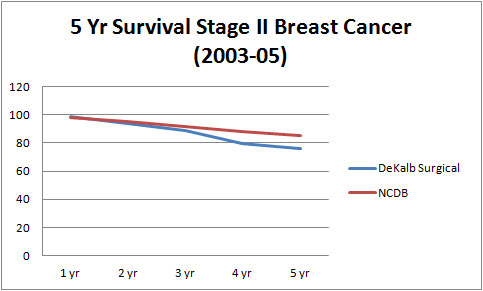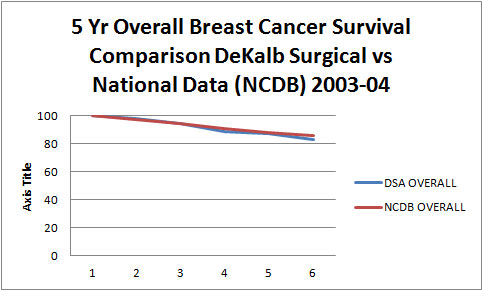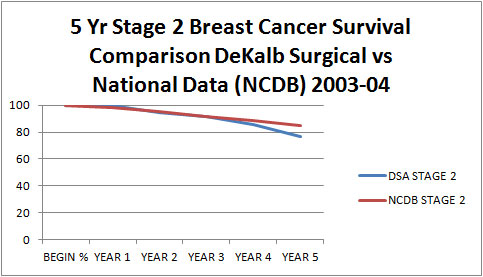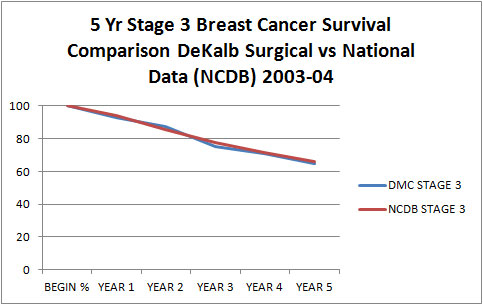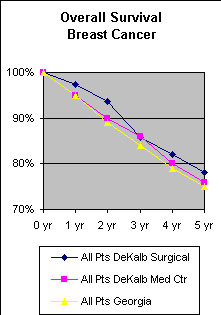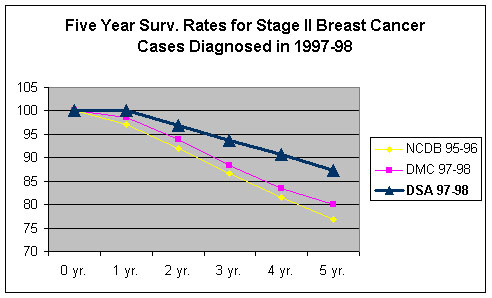5-Year Survival Rate for Breast Cancer Patients (Updated February 2012)
DeKalb Surgical Associates has implemented a method of continuous outcomes assessment for a variety of clinical indicators. One of these indicators looks at the long-term survival of patients with breast cancer. Overall five year survival for our breast cancer patients is almost 83%. This seem like a fairly significant improvement over our five year survival rates from an earlier time frame, as shown below for patients diagnosed in 1997-98 when the overall survival was about 78%. These rates can vary a bit up and down from one time frame to another without necessarily being significant, but it is certainly encouraging, and the national data shows a similar higher overall survival rate, increasing from about 76% to 85%
This data has been compared to published data from the National Cancer Data Bank, and is shown below, and includes patients from 2003-04. Our results are equivalent to national data.
Comparisons by stage 2 and 3 are shown separately below, and our rates are statistically the same as nationally reported survival rates.
These are results from older analyses, for comparison. the graph to the right shows overall survival as reported in 2005, for women diagnosed in 1997-98. Data for patients with Stage II breast cancer from 1997-98 shows similar results for this sub-group. This was the most recent data available at the time for looking at 5-year survival rates. The national data shown (NCDB, which stands for “National Cancer Data Base”) is from 1995-96. The other comparison was with all other Stage II breast cancer patients treated at DeKalb Medical Center during the 1997-98 time period. The 5-year survival for our patients was 87% compared with 80% for all other patients at DeKalb Medical Center.
Customized Surgical Device Lowers Re-Excision Rate for Breast Cancer (Updated June 2008)
Women with breast cancer can be overwhelmed with anxiety from the very moment they learn of their diagnosis. Fortunately for most women at DeKalb Surgical, the diagnosis is made early, with a correspondingly good prognosis. We then give extra effort to achieve a maximum cure with a minimum of surgery.
Particular emphasis must be given to obtaining clear margins around the lump of cancer. This is essential in assuring a low risk of local recurrence in the breast. If the margins are not clear, the patient must undergo either a re-excision, or a mastectomy. For most surgeons, anywhere from 20% to over 50% of their patients must have a second procedure to obtain clear margins. Mastectomy rates may run as high as 60%.
We have focused on this issue at DeKalb Surgical Associates over the past 6 years. As a result, our re-excision rate for breast cancer patients undergoing breast conserving surgery is only 8%. As a corollary, our mastectomy rate is also remarkably low, at less than 10%, excluding patients who present with advanced disease.
A nearby university center has actually reported their re-excision rate to be as high as 40%!! In fact, they are conducting a clinical trial to try to see if they can do better. Patients would be randomized to having the surgery done the usual way (for which they KNOW the re-excision rate will be 40%) versus a new way. This seems unnecessary in our opinion, since we already have a method for minimizing the need to return to the operating room a second time.
By minimizing the need for additional surgery, our patients complete their treatment more quickly. This helps to reduce the anxiety that comes with the diagnosis, allowing them to resume their daily routine.



